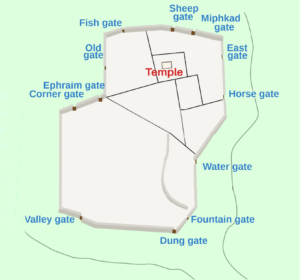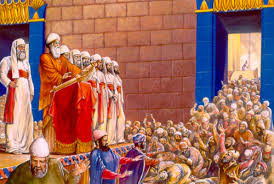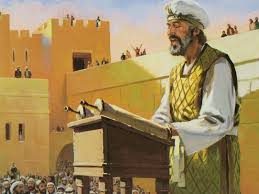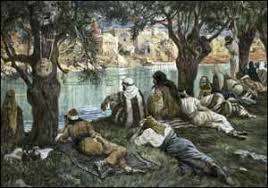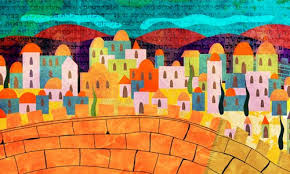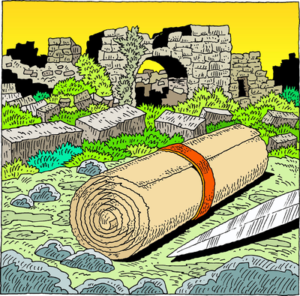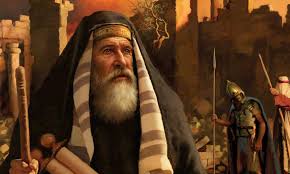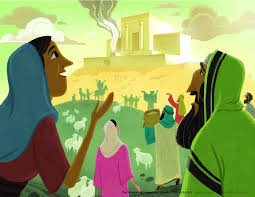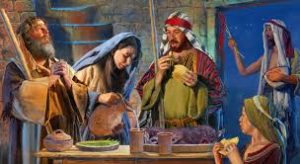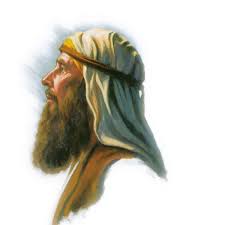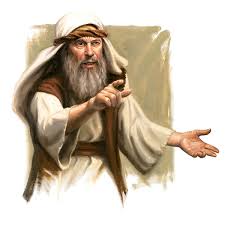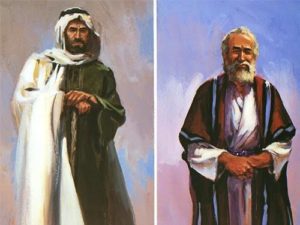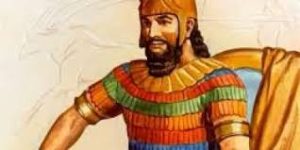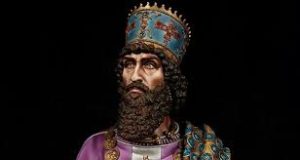Ar – El SEÑOR preparó un gran pez para tragar a Jonás 1:17 a 2:1
El SEÑOR preparó un gran pez para tragar a Jonás
1:17 a 2:1
El SEÑOR preparó un gran pez para tragar a Jonás ESCUDRIÑAR: ¿Qué es significativo acerca de la frase…Pero el Señor? ¿Qué significó para Jonás? ¿Qué significa la palabra preparada? ¿Qué implica la palabra tragar? ¿Por qué? ¿Qué tiene de paradójico el hecho de que el gran pez cumpla con su encargo? ¿Qué significa la expresión judía tres días y tres noches? ¿Dice la Biblia que Jonás estaba vivo dentro del gran pez? ¿Cómo explican los judíos la experiencia del gran pez?
REFLEXIONAR: ¿Cuál fue el significado de la sepultura de Jonás para Jesús? ¿y para usted? En cierto sentido, esta historia no es sobre Jonás, o un gran pez. Se trata de un Dios que es omnipotente y que puede hacer lo que Él quiera. Y que Él elige darnos una segunda oportunidad. ¿Cómo se le ha dado a usted una segunda oportunidad? ¿Qué hizo usted con eso?
Breve descripción de la escena tres: Cuando concluyó la escena dos, Jonás había desaparecido en las aguas del Mediterráneo y una calma misteriosa se había asentado sobre el mar. Los marineros adoraban a ADONAI con palabras, sacrificios y con su actitud en general. La historia podría haber llegado a su fin allí mismo, señalando que uno no debe tratar de huir de Dios. La narrativa, sin embargo, continúa. Pero el SEÑOR… El juego del gato y el ratón continúa como un juego de ajedrez (1:3, 1:4, 1:17, 4:1, 4:7). Aquí el Gran Maestro ha superado a Jonás. Jaque mate compañero y juego terminado. La escena tres consiste en una introducción narrativa (17:1 a 2:1), una oración (2:2-9) y una conclusión narrativa (2:10).58
 Comentario sobre la escena tres: en el texto hebreo, 1:17 es el primer versículo del capítulo 2, presentando la oración de Jonás a YHVH su Dios desde el vientre del pez (2:1). Y preparó YHVH un gran pez que tragara a Jonás (1:17), el pez apareció exactamente en el lugar correcto y en el momento adecuado para tragar a Jonás. ADONAI, que había llamado a Jonás y que había enviado la tormenta, actúa nuevamente, esta vez preparando un gran pez para llevar a cabo una tarea especial. La palabra hebrea para preparó significa asignar, contar, nombrar o comisionar. El gran pez fue nombrado o encargado de tragar a Jonás. La palabra tragar a menudo implica peligro, usada como lo es del exilio (Jeremías 51:34), del juicio de Dios (Salmo 21:9) y de las amenazas de los enemigos (Salmo 35:25). Es una paradoja que el hijo de Amitay, un ser racional, haya fallado su comisión, pero el gran pez, una criatura irracional, cumplió su comisión. Este se tragó a Jonás como le fue asignado. Los rabinos enseñan que este gran pez se creó en los seis días de la creación y se mantuvo listo para Jonás.
Comentario sobre la escena tres: en el texto hebreo, 1:17 es el primer versículo del capítulo 2, presentando la oración de Jonás a YHVH su Dios desde el vientre del pez (2:1). Y preparó YHVH un gran pez que tragara a Jonás (1:17), el pez apareció exactamente en el lugar correcto y en el momento adecuado para tragar a Jonás. ADONAI, que había llamado a Jonás y que había enviado la tormenta, actúa nuevamente, esta vez preparando un gran pez para llevar a cabo una tarea especial. La palabra hebrea para preparó significa asignar, contar, nombrar o comisionar. El gran pez fue nombrado o encargado de tragar a Jonás. La palabra tragar a menudo implica peligro, usada como lo es del exilio (Jeremías 51:34), del juicio de Dios (Salmo 21:9) y de las amenazas de los enemigos (Salmo 35:25). Es una paradoja que el hijo de Amitay, un ser racional, haya fallado su comisión, pero el gran pez, una criatura irracional, cumplió su comisión. Este se tragó a Jonás como le fue asignado. Los rabinos enseñan que este gran pez se creó en los seis días de la creación y se mantuvo listo para Jonás.
¿Qué clase de gran pez tenía en mente el autor aquí? Las traducciones griegas tienen ketai megalo (ketos en Mateo 12:40), que puede traducirse como un gran pez. Sin embargo, la palabra hebrea para gran pez no se refiere a una especie específica, pero deja espacio para la imaginación del oyente o lector.59 No nos especialicemos en los detalles menores y nos dejemos atrapar (no pretendemos hacer ningún juego) sobre qué tipo de gran pez es este. El hombre dentro del pez es mucho más importante. Lo podríamos llamar gran pez o ballena.
Y estuvo Jonás en el vientre del pez tres días y tres noches (1:17b). El renuente profeta quería ir a Tarsis, pero terminó en el vientre del pez (vea el comentario sobre La Vida de Cristo Eo – La señal de Jonás). La expresión hebrea de tres días y tres noches no requiere tres períodos completos de veinticuatro horas. Es una expresión judía común, que significa simplemente cualquier período de tiempo que toque tres días. En el cálculo judío, parte de un día cuenta por un día entero.60 Observe que la Biblia no dice que Jonás estaba vivo dentro del pez. Al final del capítulo 2, todo será despojado de él, excepto su dependencia de Dios.
Algunos de los rabinos describen la estadía de Jonás en la ballena con imaginativos detalles. De acuerdo con el Pirke de Rabbi Eliezer, Jonás evita que su pez huésped sea devorado por el monstruo marino Leviatán. A cambio de esto, el pez lleva a Jonás a un extenso recorrido por el mundo sub-oceánico. En el Zohar, la estadía de Jonás en el vientre del gran pez y su posterior expulsión se entiende como una alegoría de la muerte y la resurrección. Lo más interesante es el relato en el Midrash Jonás, aparentemente desarrollado para explicar la variación entre las palabras masculinas y femeninas para pez en estos versículos. Jonás se encontraba bastante cómodo en el gran pez, no estaba preocupado y falló en orar. Luego, el SEÑOR dispone que Jonás sea escupido del pez original (macho) (1:17, en hebreo: dag) y que sea tragado por otro pez (hembra) (2:1, en hebreo: dagah) que estaba preñada de 365.000 crías en su vientre. Jonás tenía mucho miedo por la suciedad y el rechazo de todos los peces”, e inmediatamente comenzó a orar.61
Entonces oró Jonás a YHVH su Dios desde el vientre del pez (2:1). La palabra hebrea para vientre en relación con la ballena significa el abdomen. La forma idéntica del verbo orar aparece en 4:2, donde presenta la amarga queja de Jonás al SEÑOR. El verbo orar puede designar orar por ayuda en una situación de angustia aguda (Primera Samuel 1:10; Segunda Reyes 4:33, 6:18 y 20:2), o puede introducir un salmo de acción de gracias como en Primera Samuel 2:1 y como veremos a continuación en 2:2-9.
Querido Gran Padre Celestial, No hay lugar donde alguien pueda huir de Ti. Oh YHVH, Tú me has escudriñado y conocido. Tú conoces mi sentarme y mi levantarme, De lejos percibes mis pensamientos; Escudriñas mi senda y mi reposo, Y todos mis caminos te son conocidos, Porque aún no está la palabra en mi lengua, Y he aquí, oh YHVH, Tú la sabes toda. Me has constreñido por detrás y por delante, Y has puesto sobre mí tu mano. (Salmo 139:1-5). Si tomara las alas del alba, y habitara al extremo de los mares, Aun allí me alcanzará tu mano, Y me asirá tu diestra. Si digo: ¡Sórbanme las tinieblas, Y que la luz en torno a mí se haga como la noche! Tampoco la oscuridad es oscura para ti, La noche resplandece como el día, ¡Lo mismo te son las tinieblas que la luz! (Salmo 139:9-12). ¡Tu cuidado vigilante es maravilloso! Tú eres un gozo y un consuelo confiable, para amar y obedecer. ¡Cuán maravilloso será alabar Tu grande y santo nombre en el cielo para siempre! En el santo nombre de Yeshua y el poder de Su resurrección. Amén.



 Muchos eruditos de la Biblia dicen que la palabra en el Nuevo Testamento griego traducida al inglés como ballena (griego: cetos o kétos) podría traducirse con la misma precisión simplemente como un gran pez o un monstruo marino. Sin embargo, al defender la Palabra de Dios, no es realmente necesario descartar la posibilidad de que esta palabra griega pudiera significar ballena. Hay dos razones para esto. Primero, algunos estudiosos dicen que hay una especie de ballena que no solo tiene una boca lo suficientemente grande como para que ingrese un hombre, sino que también tiene una garganta lo suficientemente grande como para que la esa ballena lo trague. Y segundo, incluso si no hay una especie de ballena hoy con una garganta lo suficientemente grande para que un hombre la atraviese, Dios ciertamente podría haber preparado una ballena con la boca y la garganta lo suficientemente grande como para que Jonás fuese directamente al estómago de la ballena, porque la Biblia nos dice que preparó YHVH un gran pez que tragara a Jonás. Y estuvo Jonás en el vientre del pez tres días y tres noches (Jonás 1:17a).
Muchos eruditos de la Biblia dicen que la palabra en el Nuevo Testamento griego traducida al inglés como ballena (griego: cetos o kétos) podría traducirse con la misma precisión simplemente como un gran pez o un monstruo marino. Sin embargo, al defender la Palabra de Dios, no es realmente necesario descartar la posibilidad de que esta palabra griega pudiera significar ballena. Hay dos razones para esto. Primero, algunos estudiosos dicen que hay una especie de ballena que no solo tiene una boca lo suficientemente grande como para que ingrese un hombre, sino que también tiene una garganta lo suficientemente grande como para que la esa ballena lo trague. Y segundo, incluso si no hay una especie de ballena hoy con una garganta lo suficientemente grande para que un hombre la atraviese, Dios ciertamente podría haber preparado una ballena con la boca y la garganta lo suficientemente grande como para que Jonás fuese directamente al estómago de la ballena, porque la Biblia nos dice que preparó YHVH un gran pez que tragara a Jonás. Y estuvo Jonás en el vientre del pez tres días y tres noches (Jonás 1:17a). 
